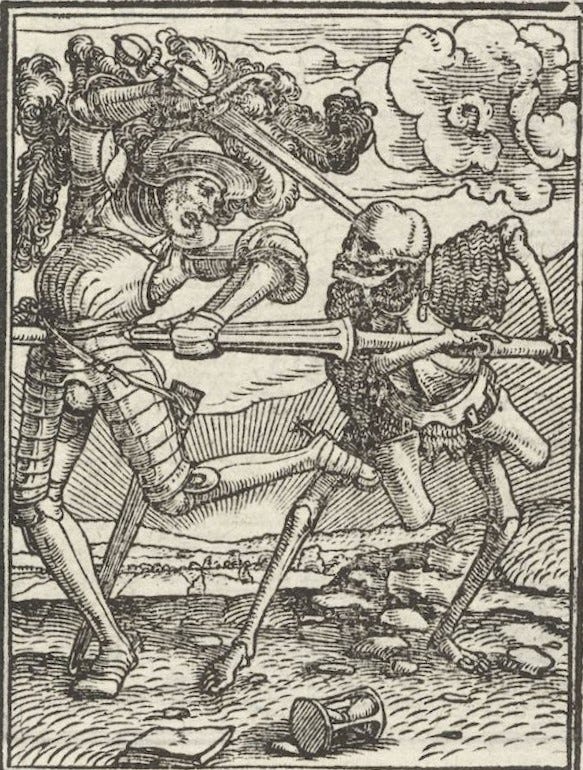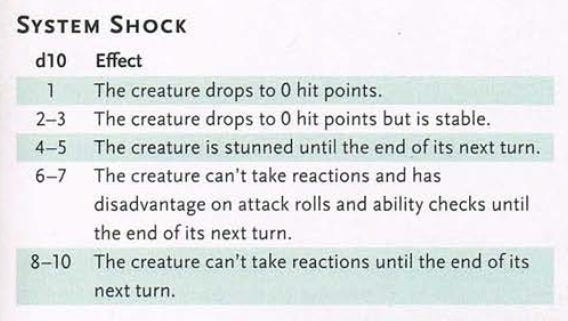Death & Dying Rules in Every Edition of D&D and Then Some, Part 2: Massive Damage
Damage so devastating it bypasses other death rules. Rules ranked by deadliness.
Death & Dying Rules in Every Edition of D&D and More
Massive damage
Coming up
As mentioned in Part 1 on coups de grâce, D&D characters with large numbers of hit points can trivialize otherwise devastating amounts of damage and as a result threaten verisimilitude. D&D’s designers have thought to include rules to mitigate this tendency. Whereas coup de grâce rules address this problem in situations outside the fray, massive damage rules attempt to lend plausibility to gameplay when even awake and capable characters are harmed in ways that the game’s fiction suggests should be life threatening, such as being crushed by a titan’s hammer, being engulfed by an ancient dragon’s flames, or being unsaddled while riding a griffon through the clouds.
Massive damage rules were introduced to address situations where a single attack or other instance of damage inflicts so much damage that the fiction of the game demands that the victim face the prospect of immediate death, no matter how many hit points they have.
In AD&D 2nd edition and D&D 3.5, a character dealt 50 or more damage by a single attack or effect must roll a saving throw (vs. death in 2nd edition, a Fortitude saving throw in 3.5 edition). If the saving throw fails the character dies regardless of current hit points.
Pathfinder 1st edition has an optional rule that works the same way except the amount of damage that must be dealt by a single effect is 50 or a half a character’s hit maximum hit points, whichever is higher.
D&D 5th edition has two rules that could be called massive damage rules. One optional and one a part of the default dying rules. The optional “massive damage” rule is closest to the previous examples, so I’m including it first.
When a single source deals damage to a creature equal to or greater than half the creature’s hit point maximum, the creature must roll a Constitution saving throw. If that roll fails, the referee or player rolls on the System Shock table.
You can see that worst result on the table merely commences 5th edition’s dying rules, where the character can make three to five saving throws over the course of the same number of rounds to determine their fate, rather than instant death as in the previous examples. And that worst result only has a 1-in-10 chance of occurring. But between the first two results there is a combined 3-in-10 chance that a character’s hit points are bypassed.
Now three games have rules that bypass special dying rules rather than bypassing hit points.
Player characters in D&D 4th edition die when they are reduced to negative hit points equal to half their hit point maximum. This doesn’t require the damage come from a single attack or instance since negative hit points are tracked in between instances of suffering damage. The character dies regardless of where they are at in the death saving throw process.
By D&D 5th edition’s default rules characters die instantly when reduced to negative hit points equal their hit whole hit point maximum. This however does require the damage to come from a single attack or instance since 5th edition doesn’t track negative hit points. Damage cannot reduce a character below 0 hit points unless it deals enough to slay them. As in 4th edition, the character dies regardless of where they are at in the death saving throw process.
In Starfinder, a character dies if they are reduced to 0 hit points and the remaining damage from a single effect would reduce them the negative of their hit point maximum.
These last three almost shouldn’t count as a massive damage since it doesn’t so much mitigate the effects of high hit points. But they do bypass the death saving throw mechanics in the 4th and 5th editions of D&D and the dying rolls involving loss of Resolve Points specific to Starfinder, thus they hasten the journey towards death and raise the stakes. These last three rules also only apply to player characters since monsters and NPCs usually die when they reach 0 hit points already. You could say these are limitations on the plot armor granted to player characters by the game.
I could not find similar damage rules in other versions of the game. As with coup de grâce rules, massive damage rules may be less necessary in versions of the game with lower hit point totals. Keeping the number of hit points down (or more precisely, keeping the hit point-to-damage ratio down) is a more elegant way of avoiding the problem than introducing another rule. But some games like Pathfinder 2nd edition have large numbers of hit points and also lack massive damage rules.
Deadliness Rankings
If I only include the tradition massive damage rules that bypass hit points, from most to least deadly the rankings are:
AD&D 2nd edition, D&D 3.5 edition
Pathfinder 1st edition (optional rule)
D&D 5th edition (optional rule)
Few sources can deal over 50 points of damage in the editions where that it is the threshold for damage to be considered massive but those that can should be feared. But the massive damage rules can also benefit the player in these editions since they often battle creatures with more than 50 hit points.
Death is not automatic with any of the traditional massive damage rules where damage must reach or exceed a threshold (50 hit points of damage or damage half of the victims maximum hit points in these examples). All examples include a roll.
Introducing these rules means that even very high level characters venturing into dungeons with full hit points must be wary of the unknown dangers that lurk in the darkness. They don’t have to wait until they’re a few battles and traps in to start feeling the pressure.
If we also include rules for bypassing death saving throws and dying levels the rankings become:
AD&D 2nd edition, D&D 3.5 edition
Pathfinder 1st edition (optional rule)
D&D 4th edition
D&D 5th edition default Instant Death rule, D&D 5th edition optional Massive Damage rule, Starfinder
In the six years I spent playing D&D 5th edition, I only saw say the Instant Death rule come up with really low level characters, often level 1s playing in games that also had higher level characters.
While death is not the only form of stakes in many battles, its still one of the stakes. Deadlier systems raise the stakes of battle, which can encourage players to look for solutions other than fighting or at least to approach battles in a more clever way. It can also make battles more thrilling and decisions more meaningful. Other tables may wish to give players more plot armor. They want the possibility of death to exist but made unlikely.
Rulings & Rules
If characters’ hit points are growing so high they are rarely threatened or your game’s dying rules delay death to a degree you find implausible, you can introduce massive damage rules to partially mitigate this. These are probably best introduced as house rules agreed to in advance rather than as on the fly rulings, especially when player characters are hit by massive damage. But you could use them as rulings when monsters suffer mighty blows by player characters or if the player characters manage to knock a huge monster off a perilous cliff and the fall damage deals a tremendous amount of damage but not enough to slay the monster outright. You could also rule that some monsters are big or strange enough that massive damage rules don’t apply.
The threshold for damage to count as “massive” could also be lowered. If you want to level the playing field between high level characters, including monsters and NPCs, and low level characters or monsters, you could make 20 or even 10 the threshold. This would mean most attacks only subtract hit points but if the low level characters get especially lucky or are able to engineer some unusual circumstance letting them do more damage than the maximum of their usual attack, such as hitting their target with a ballista bolt point blank. Battles could become more decisive, where the goal isn’t just to chip away at hit points but to discover a way to set up a single tremendous blow or trick an enemy into a powerful trap to end the battle “early” and with minimal casualties.
You could instead consider a house rule to 1) reduce the number of hit points characters gain per level, 2) for characters to stop gaining hit points after a certain level, or 3) to stop leveling entirely after a certain level (the most common house rule along these lines that I’ve seen stops leveling at 6th or 7th level. This rule is popular enough that it pops up in D&D rules variants published by smaller companies). These solutions would likely obviate the problem that massive damage rules attempt to solve.
The next part of this series will cover the core death mechanics in TSR-era editions of D&D and newer games that take their inspiration primarily from those editions.



